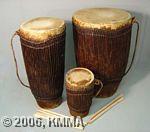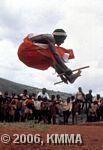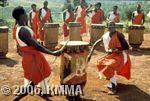









The ingoma is a drum covered with a membrane of animal skin. The top of the drum is always broader than the bottom. The ingoma is usually cylindrical in form, tapering only in the lower section of the instrument, although the drum shell can also taper gradually over its entire length. Making an ingoma is a long and delicate process and is therefore entrusted to specialised drum makers, assisted by a woodworker who prepares the hide.
The drum shell (resonator) is a hollowed-out tree trunk, usually from the umuvugangoma, which literally means ‘the wood that makes the drum resonate’, although other types of trees are also suitable. The drum maker chooses a tree from which he can make four or five ingoma. Once the tree has been felled and sawn up, the trunk is left in situ to allow it to dry out for a while before being roughly hollowed out. Further work on the trunk is carried out at the drum maker’s home. The outside is polished and the inside is hollowed out further until the walls are about 20-23 mm thick. The size of the drum shell may vary from 40 to 130 cm high with a diameter of 50 to 70 cm at the top and 10 to 20 cm at the bottom. Nowadays a metal barrel (200 l) can also be used to make a drum, which is not only cheaper but also easier to make. The sound it produces is not comparable to that of a wooden drum, however, so that only a few drums are made this way. Both openings of the drum shell are then covered with hide, the hairy side of the pelt on the outside. To prepare the hides, they are first soaked, then scraped to remove meat, fat and membranes and finally stretched and left to dry in the sun. The way in which the hides are stretched over the drum shell is peculiar to the ingoma and differs from the method used for other membranophones. Narrow strips of hide affixed vertically bind the top membrane to the bottom membrane and keep them both taut over the drum shell. The process of tightening is complex, involving several people to ensure that everything proceeds correctly. Large instruments need about 50 running metres of these strips of hide.
The ingoma ensemble that plays nowadays comprises eight to ten drummers, each with his own drum. There are three types of drum, each having a different pitch: the ishakwe, the inyahura and the igihumurizo:
The ingoma is only played by men on festive occasions or to welcome an important guest. The drummers use two wooden sticks called imirishyo. To ensure that the instrument plays the right tone, the membrane is warmed up by placing it near a fire or in the sun.
For more information consult the following publications edited by the RMCA:
© KMMA/Jos GANSEMANS